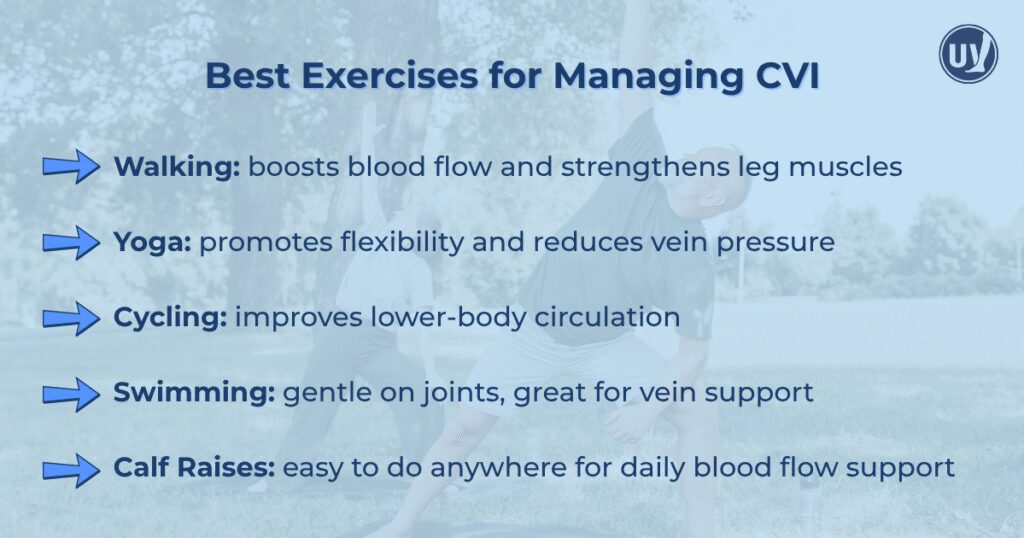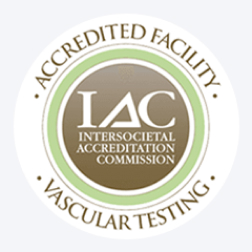Living with chronic venous insufficiency (CVI) can make even simple daily activities feel challenging. Swelling, heaviness, and discomfort in the legs are common, but with the right approach, you can take meaningful steps toward relief.
Exercise is one of the most effective ways to support vein health and improve circulation. Gentle, consistent movement helps reduce swelling, manage weight, and ease pressure on your veins, all while boosting your overall energy and mobility.
The key is choosing exercises that strengthen your legs without adding unnecessary strain. From walking and swimming to simple leg lifts at home, the right activities can make a big difference in how you feel day to day.
Understanding Chronic Venous Insufficiency and the Role of Exercise
Chronic venous insufficiency occurs when veins in the legs struggle to send blood back to the heart. This can lead to various symptoms, including leg pain, swelling, and a sense of heaviness.
Exercise is crucial in managing CVI because it enhances circulation and strengthens the muscles that aid vein function. By moving your body, you help blood flow more effectively, reducing the risk of blood pooling in the legs.
Key benefits of incorporating exercise for CVI include:
- Improved blood flow
- Strengthened leg muscles
- Reduced symptoms like swelling
Taking the first step toward managing CVI with exercise starts with choosing activities that match your capabilities. While it may seem challenging, simple exercises can make a significant difference in your health and comfort.
Benefits of Exercise for Vein Health
Exercise offers numerous advantages for those with chronic venous insufficiency. Regular physical activity helps improve blood circulation, which is essential for managing vein health effectively.
When you exercise, muscles in your legs contract, which assists in pushing blood back towards the heart. This action reduces the likelihood of blood pooling and minimizes swelling and discomfort.
Moreover, exercising contributes to maintaining a healthy weight. Excess body weight can put additional pressure on the veins, exacerbating symptoms of CVI. By staying active, you can help alleviate some of this pressure.
General Guidelines for Safe Exercise With CVI
When exercising with CVI, prioritizing safety is essential. Begin by consulting your healthcare provider before starting any new workout routine. This step ensures that your planned activities align with your medical needs and limitations.
Choose low-impact exercises that minimize strain on your veins, such as walking or cycling. These activities encourage circulation without exerting excessive pressure on your legs. Additionally, wearing compression stockings during workouts provides extra support for your veins, helping to prevent swelling.
Here are some key guidelines for exercising safely with CVI:
- Start slow and gradually increase your activity level
- Stay hydrated to support overall circulation
- Listen to your body and rest when needed
Avoid high-impact sports and prolonged standing or sitting. These activities may worsen your symptoms by promoting blood pooling. By following these guidelines, you can exercise safely and effectively, improving your overall vein health and wellbeing.
Best Types of Exercise for Chronic Venous Insufficiency
Engaging in the right types of exercise can significantly improve the symptoms of chronic venous insufficiency. Opting for low-impact and vein-friendly activities is crucial to avoid exacerbating the condition.
Exercises that promote blood flow and strengthen leg muscles are ideal for supporting vein health. Such workouts help reduce swelling and discomfort by improving circulation and muscle tone.
Some excellent exercise options include:
- Walking, a simple but effective way to boost circulation
- Swimming and cycling, which provide cardiovascular benefits without heavy joint impact
- Yoga and stretching exercises that enhance flexibility and promote blood flow
Incorporating these exercises into your routine can yield significant benefits for vein health. Always remember to start gently, increasing intensity and duration as your body allows.
Leg Strength Workouts for Vein Support
Developing strong leg muscles provides crucial support for your veins, especially when dealing with CVI. Muscle contraction facilitates blood movement back toward the heart, reducing pressure on vein walls.
Leg strength workouts are simple yet effective ways to bolster vein health. They can be easily incorporated into your daily routine without the need for special equipment.
Consider these exercises for optimal benefits:
- Calf raises strengthen the lower leg muscles
- Leg lifts engage the thighs and improve circulation
- Ankle pumps promote blood flow through gentle movement
Regularly practicing these workouts can help alleviate symptoms of CVI, such as swelling and leg heaviness. These exercises are accessible for most fitness levels and can be performed at home or in any comfortable setting.
By dedicating a short time each day to leg-strengthening activities, you’ll support overall vein health, enhancing your quality of life.

Tips for Maximizing Results and Staying Motivated
Staying consistent with your exercise routine can be challenging, but these tips can help you maximize results and remain motivated.
Staying flexible with your workout plan allows for adjustments based on how your body feels. Remember, gradual improvements contribute to long-term success in managing chronic venous insufficiency.
What to Avoid: Exercises and Habits That May Worsen CVI
Certain exercises and habits can exacerbate symptoms of CVI. It’s important to identify and steer clear of these activities to prevent worsening your condition.
High-impact exercises can strain your veins and should be avoided. Additionally, try not to stand or sit for prolonged periods without movement.
Habits and exercises to avoid include:
- Running or jogging on hard surfaces
- Heavy weightlifting that strains the lower body
- Sitting or standing still for extended durations
By staying mindful of these factors, you can better manage your symptoms and protect your vein health.
When to Consult Your Healthcare Provider
Consulting your healthcare provider is crucial when managing chronic venous insufficiency. They can guide you to ensure your exercise routine is safe and effective.
Engaging with your healthcare provider helps tailor your routine to your specific needs, enhancing your overall well-being.
Empowering Yourself Through Movement
Exercise is one of the best ways to take control of chronic venous insufficiency and support your long-term vein health. Every step, stretch, and movement helps improve circulation, reduce discomfort, and boost your overall well-being.
If you’re unsure where to start or want guidance on creating a safe, effective routine, the specialists at United Vein & Vascular Centers are here to help. Schedule a consultation today to take the next step toward stronger veins, better mobility, and a healthier, more active life.
Frequently Asked Questions
Low-impact activities like walking, swimming, cycling, and leg lifts are ideal for improving circulation without straining the veins. These exercises help reduce swelling and support overall vein health.
When done correctly, exercise actually helps manage CVI symptoms. However, high-impact or heavy weight-bearing activities can add pressure to the veins, so it’s important to follow guidance from a vascular specialist.
Consistency is key. Aim for 30 minutes of low-impact movement most days of the week. Even short, frequent walks or simple calf raises throughout the day can make a big difference in circulation and comfort.


